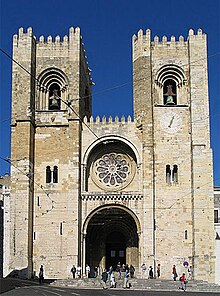Catedral Sé Patriarcal
The Catedral Sé Patriarcal , also called Igreja de Santa Maria Maior , is the main church of the city of Lisbon and the cathedral of the Patriarchate of Lisbon .
Building history
The building is on the site where a mosque used to be . Construction began in 1147, making the Catedral Sé Patriarcal the oldest church in the city. In 1344 an earthquake caused some damage. In 1380 the western facade was built in the Romanesque style.
The earthquake of 1755 caused further damage, including the destruction of the Gothic choir . In the 18th century the towers were crowned with spikes in the Baroque style . The tips were dismantled during the reign of António de Oliveira Salazar in order to achieve a uniform appearance in the Romanesque style. At the same time, the battlements were restored and the portal-like window in the west facade was replaced by a rose window .
inner space
The interior of the cathedral is designed in the styles of the Romanesque and Gothic, whereby the Gothic can be found predominantly in the area of the choir. The ceiling of the church was painted in the Baroque period. One of the organs also comes from this period .
The remodeling of some of the chapels in the styles of baroque, rococo and classicism was reversed in the 20th century.
The baptismal font , in which, according to tradition, Saint Anthony was baptized in 1195 , dates from the 12th century. In one of the chapels there is the nativity scene created by Machado de Castro from 1766.
Organs
The cathedral has two organs . On the gospel side of the chancel there is a historical, single-manual organ, which was built around 1788 by the organ builder Joaquim António Peres Fontanes.
The organ on the Epistle side was built in 1964 by the Flentrop organ building company. The instrument has 51 stops on four manuals and a pedal .
|
|
|
|
|
|||||||||||||||||||||||||||||||||||||||||||||||||||||||||||||||||||||||||||||||||||||||||||||||||||||||||||||||||||||||||||||||||||||||||||||||||||||||||||||||||||||||||||||||||||||
- Coupling : I / II, III / II, I / P, II / P, III / P
Cloister
The cloister to the east of the cathedral was built at the end of the 13th century under the rule of King Dionysius and in the 14th century. There is an archaeological exhibition that shows the remains of ancient buildings and an iron grating in the Romanesque style.
literature
- Hans Strelocke: Portugal. DuMont Buchverlag, Cologne 1994, pp. 83-85, ISBN 3-7701-1369-1
Individual evidence
- ↑ Information on the historical organ
- ↑ Information on the organ
Web links
- Official website of the Patriarchate of Lisbon (Portuguese)
Coordinates: 38 ° 42 ′ 35 " N , 9 ° 7 ′ 59" W.





